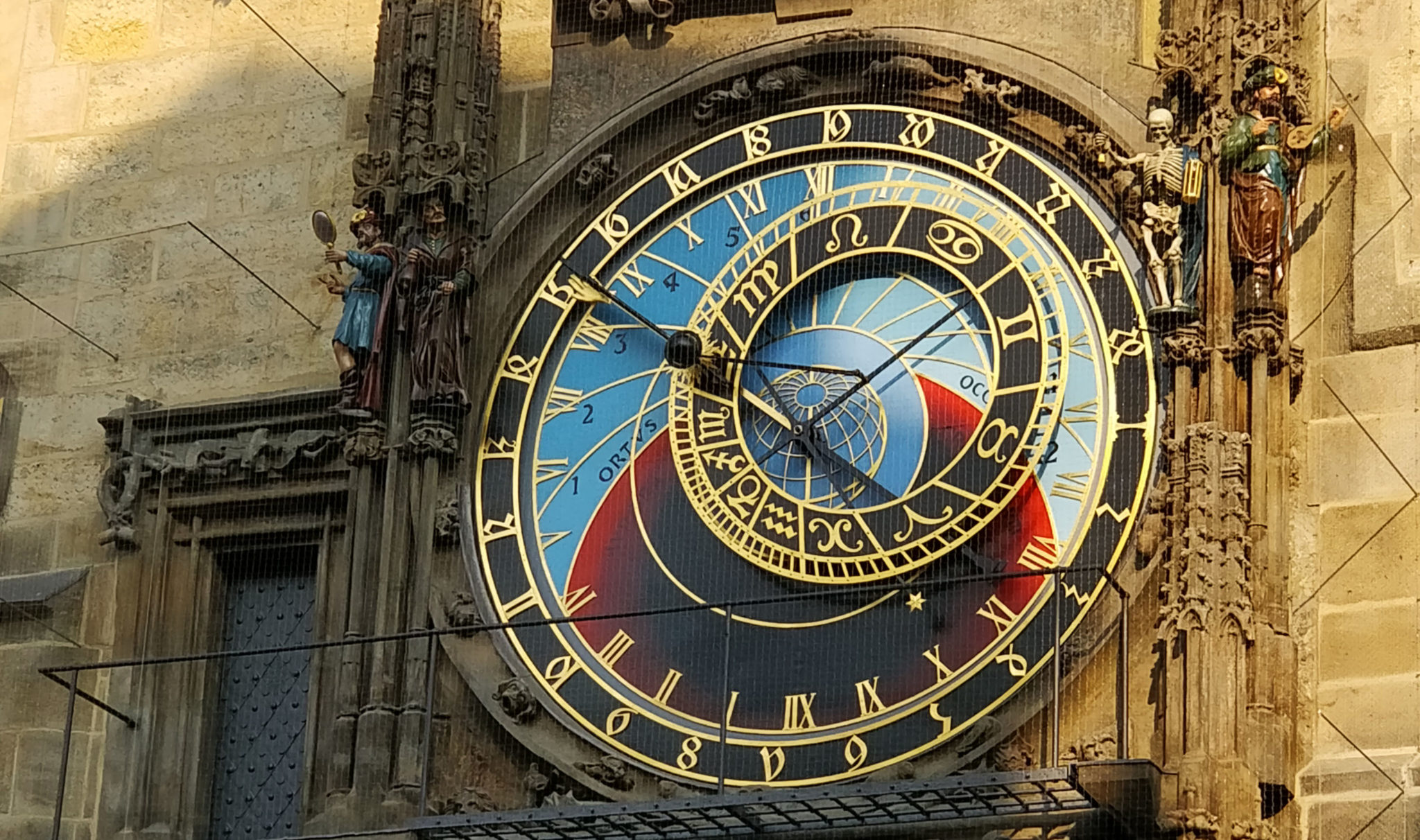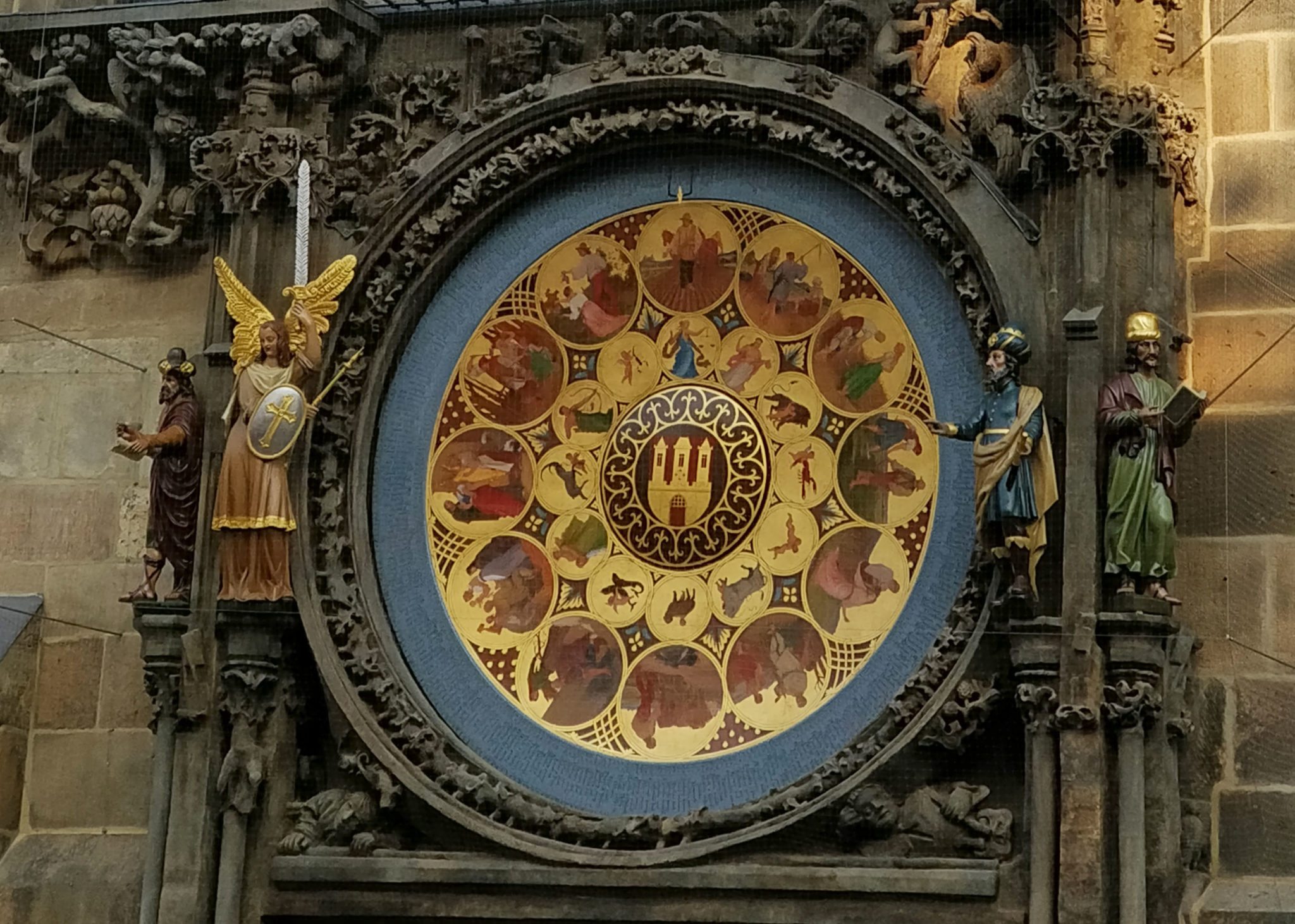Paris has the Eiffel Tower, London has the Tower Bridge, New York has the Times Square. Major tourism destinations usually have an iconic sight, and you can’t say you’ve been there if you hadn’t seen it. In Prague, that sight is the Astronomical Clock.
Sure, the Charles Bridge and the Prague Castle deserve their fair share of Instagram likes, but it’s the Astronomical Clock that stands out the most.
The First “Tick”
As is often the case in cities with more history than people who could write it down, the origins of the Astronomical Clock are shrouded in mystery. We do know, however, that the first historical record of the clock is on the 9th of October, 1410.
In the record, the councillors thank Mikuláš (Nicholas) of Kadaň for the clock’s creation, and we even get a mention of the compensation he got for his incredible work. Mikuláš received a house near Havel’s Gate (today near the Můstek metro station).
He also received a lump sum of 3,000 groschen and a yearly salary of 600 groschen for maintaining the clock. And in case you’re not up to speed on conversion rates between the euro and six-hundred-year-old Bohemian silver coins, it’s the equivalent of roughly 52,000 euro today, with a yearly salary of 10,000 on top of that.
Not a bad deal for a clock, although if you consider that the clock is still a major attraction six hundred years later, he really should have thought of some royalty agreement, too.
A Clock Like Fine Wine
Historically, patience was not so much a virtue as a requirement. Things took time. Right across the Old Town Square from the Astronomical Clock, the beautiful Church of Our Lady before Týn took a solid 150 years to build. The most incredible gothic cathedral in Bohemia, the St. Vitus Cathedral at the Prague Castle, that was 585 years from start to finish.
And the Astronomical Clock? It took a while to become the wonder it is today. It started in 1410 with Mikoláš of Kadaň, but the last major change happened as recently as 136 years ago.
After Mikuláš, the next major name in the clock’s history is Jan Růže (John the Rose), also known as Master Hanuš, in 1490. For centuries we thought he was the clock’s original creator, and as a result he became the centre of a dreadful legend. More on that in a second.
Hanuš added more astronomical features to the main dial, essentially bringing it to present state. He was also responsible for adding the skeleton figure to the right of the main dial. This spooky skeleton became known as Klapáček (the Clapper), because his jaws used to open and shut every hour. Hanuš also created the first calendar dial on the clock.
The next major addition was in 1659, when the country was beginning to recover from the destruction of the Thirty-Years War that ended in 1648. The clock was repaired extensively and expanded upon with the addition of the animated wooden figures. They were meant as a representation of the most dreadful things a person could be: Vanity, holding a little silver mirror. Greed, with a bag full of coins. And the Turk, with a lute and a ton of political incorrectness.

Throughout the 18th century, the clock was several times threatened with removal. Many considered it an anachronism, a relic, and a pretty but broken hunk of junk.
Nothing came of it, luckily, and by the 19th century the public perception of the Clock changed. It was during the National Revival era that many artists and public figures started to recognise the incredible value of the clock, and in 1866 the clock was restored once again.
Josef Mánes, a brilliant painter of the era, contributed with a major addition: the new calendar dial that (although now a replica with the original kept in the City of Prague Museum) still works today. And while we’re not 100% sure, it was likely here that the Apostles arrived as well, twelve statues that shuffle past the little blue windows with silver stars every hour.

The clock nearly complete, the last touch was the golden rooster in 1882 during another reconstruction of the Old Town Hall.
A Show to Remember
The Astronomical Clock is without doubt more than the sum of its parts. Already quite astonishing is the fact that roughly 75 per cent of the mechanical parts of the clock are authentic, dating back to the 15th century. That alone makes it the best preserved medieval clock in the world.
But gears, cogs and levers hardly bring thousands upon thousands of people to the clock every hour. There’s something more – a spectacle worth a journey across the globe.
I’m exaggerating, of course. If I’m honest, the clock’s hourly performance may very well be the greatest let down in the entire city of Prague, and in my personal experience rivals the famous disappointments like Stonehenge and the Mona Lisa. What’s the problem?
We have been spoiled for entertainment in the last 100 years. With the invention of first the radio, then television, and finally the internet, we are used to hearing and seeing incredible things every hour of every day. How could the Astronomical Clock ever compete?
I’ll ask you to forget about the marvels of our modern entertainment for a minute, and enjoy the clock with 19th century eyes.
The first thing every hour is the ringing of a bell brought upon by the Clapper, the skeleton to the right of the main dial.
On that signal the three figures on his level start shaking their heads while the skeleton nods ominously. What are they saying? My personal belief when I watch the show goes something like this:
The skeleton, clearly and unsurprisingly, stands for memento mori (“remember death”), a reminder of a universal truth that life is fleeting and death inevitable.
The statues of Vanity, Greed and… Turkishness? The three other statues on the same level, anyway, shake their heads to warn us. “Don’t be like us,” they seem to say in mechanical unison, “don’t be vain, don’t be Turkish, don’t be a greedy Jew.”
I feel this is a good point to remind you that many views once universally held around the country are no longer popular. We are not perfect, but the levels of anti-Semitism and general xenophobia around the country don’t compare to what there was in the middle of the 17th century.
Offensive prejudice aside, along with the shaking and nodding of the wooden statues, the blue doors with silver stars above the main dial open, and behind them, the Twelve Apostles walk by. With the Apostles comes the promise of salvation through Christianity, of course.
And then the rooster crows – an ancient symbol of the dawn of a new day. We’re still alive and there’s time for us yet to be virtuous, to be good, to be saved.
And if you feel that’s all a bit heavy, well, it gets better.
The Clock of Legends
It wouldn’t be Prague if there weren’t grizzly legends and spooky stories, and the Astronomical Clock is eager to please.
The most famous legend concerns Hanuš, the long-believed creator of the clock from 1490. One night, not long after the clocks creation, masked men broke into Hanuš’s house, overpowered the clockmaker and burned out his eyes. Hanuš put two and two together and came up with a plan to get revenge. His assistant helped him get to the clock’s mechanism, and Hanuš stood there, surrounded by the wheels and weights, and listened. When the clock started striking the hour, he quickly reached into the mechanism. His eyes couldn’t see, but his mind knew exactly what to do. He yanked out a vital piece, the gears churned, screeched and cracked, and the clock feel silent. There was only one person who could fix it, and he lay there on the floor, as lifeless as his life’s work.
Parphrased from Alois Jirásek, 1894
Another legend includes ghosts, an addition I can always get behind.
It was a fateful day, the 21st of June, 1621. Especially for the twenty-seven men, leaders of an uprising against the Habsburg emperor Matthias, who were executed in the Old Town Square. Some of them were beheaded, some hanged, but they sacrificed their lives in a fight they believed to be for the good of the people of Bohemia. Even in death, their greatest concern is with their people, and so every year they gather, on the 21st of June, and stand beneath the clock. If they see the clock is well maintained, if it runs on time, they smile and peacefully disperse. But if they see a clock that’s broken, they hang their heads, they cry, and their wailing can be heard in the streets of the Old Town, because they know their country has fallen on hard times.
Paraphrased from Václav Cibula, 1972
The last legend to note does away with magic, ghosts of gruesome violence, and it might be the one to close off with.
A knight once had a long feud with the Old Town, and being a man of rash action, he took his anger out on its people, robbing and stealing in the area. But he was captured and jailed in the Old Town Hall, and from the little window of his cell he had a good view of the clock. The councillors sentenced the knight to death, and he could hardly bear looking at the skeleton on the clock as it reminded him of his fate. One day, shortly before the sentence was to be carried out, something unusual happened. Every hour, as the clock started ringing, the jaws of the skeleton started chattering, opening and closing. And just as the jaws were snapping shut, a sparrow flew into the skeletons mouth, becoming trapped. The knight observed the situation with keen interest and a great deal of commiseration, and it was a whole hour before the jaws opened again, and the bird flew away, free. The knight felt his heart fill with hope, if there was hope for the bird, perhaps there was hope for him, too. And indeed, the very same day his crimes were pardoned, the old feud settled, and the knight walked free.
Paraphrased from Josef Svátek, 1883
Of Icebergs and Clocks
The Astronomical Clock is a remarkable piece of Prague, and I hope I managed to show you why I feel it stands out as a symbol of the beautiful city. But as much as I shared with you, I really only scratched the surface here.
And so I promise we’ll return to the clock. We’ll talk about the incredible accuracy of its astronomical dial and the things it tells us about the universe around our little planet. We’ll talk in more detail about the calendar dial, and the different ways it helps people figure out the year as it passes.
For now, I hope you see the Astronomical Clock as a beautiful device that is not unlike the city in which it stands: it started out amazing, it’s been through a lot, it’s become even more amazing over the centuries, and it means a great deal to us today.




